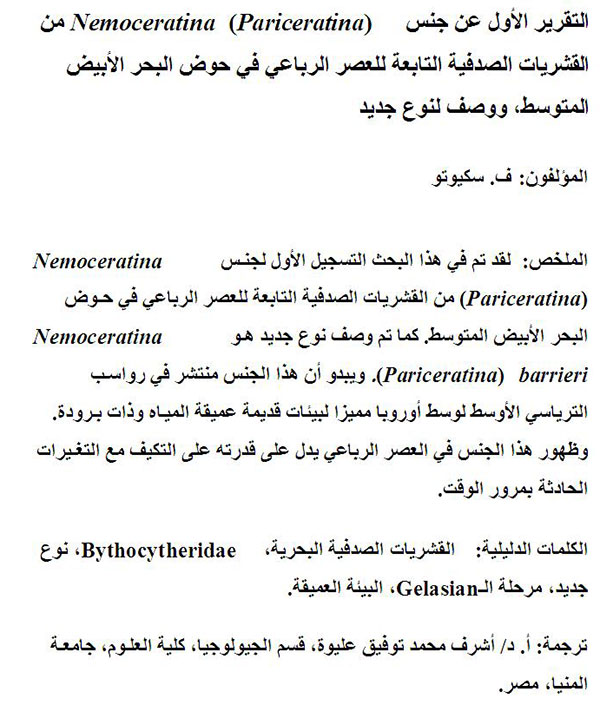First report on the palaeopsychrospheric ostracod genus Nemoceratina (Pariceratina) Gründel and Kozur, 1972 (Ostracoda, Bythocytheridae) from the Quaternary of the Mediterranean basin and description of a new species
Plain Language Abstract
The ostracod genus Nemoceratina (Pariceratina) Gründel and Kozur,1972 (Ostracoda,Bythocytheridae) was found for the first time in the Pleistocene of the Mediterranean area and a new species Nemoceratina (Pariceratina) barrieri n. sp. has been described. The specimens have been discovered in "Cala S. Antonino" (Cape Milazzo Peninsula, NE Sicily) in Gelasian sandy-silty sediments cropping out in unconformity on Tortonian conglomerates. The genus Nemoceratina appears for the first time in the Middle Triassic of Central Europe and seems quite widespread in the Mesozoic. Reports are rare in the Tertiary and even more infrequent in the Quaternary. In the Mesozoic, it was included between the palaeopsychrospheric ostracod assemblage. As a consequence, the genus Nemoceratina can be regarded as a marker of palaeoclimatic and palaeoecological conditions characteristic of the deeper Triassic ocean waters. Further discoveries of Nemoceratina in the post Eocene, with the beginning of the modern psychrosphere, show that this genus would tend to maintain its palaeoecological characteristic. Moreover, it is likely that the stability of the chemical-physical characteristics of the deepwater palaeoenvironment, and especially of the psychrosphere, would permit the survival of the genus. Therefore, it will be advanced that the specimens of Nemoceratina (Pariceratina) barrieri n. sp. found in the Mediterranean Pleistocene deep water deposits can be considered as a residual element of the Tethyan ostracod fauna.
Resumen en Español
text
Traducción: Enrique Peñalver
Résumé en Français
Premier rapport sur le genre d'ostracode paléopsychrosphérique Nemoceratina (Pariceratina) Gründel et Kozur 1972 (Ostracoda, Bythocytheridae) du bassin méditerranéen du Quaternaire et description d'une nouvelle espèce
La première apparition du genre d'ostracode Nemoceratina (sous-genre Pariceratina) Gründel et Kozur 1972 (Podocopida, Bythocytheridae) dans le Quaternaire de la région méditerranéenne est signalée et l'importance paléoenvironnementales de ce genre paléopsychrosphérique est discutée dans le contexte de l'histoire géologique de la Paléotéthys. Une nouvelle espèce Nemoceratina (Pariceratina) barrieri n. sp. est décrite. Les spécimens ont été découverts à "Cala S. Antonino" le long de la pente ouest de la péninsule du Cap Milazzo (Sicile nord-est) dans des sédiments sablo-vaseux Gélasien affleurant en discordance sur un conglomérat attribué au Tortonien (Miocène supérieur) et formé à la suite de l'érosion des roches métamorphiques sous-jacentes appartenant à la "Complexe Calabride". Le genre Nemoceratina semble être répandue dans les sédiments du Trias moyen de l'Europe centrale, où il est considéré comme un ostracode paléopsychrosphérique, c'est à dire, un marqueur de conditions paléoclimatiques et paléo-écologiques caractéristique des eaux océaniques profondes et froides du Trias. Monoceratina se raréfie dans le Cénozoïque, mais conserve ses caractéristiques psychrosphérique. Le genre est très rare dans le Quaternaire, et sa découverte dans des sédiments du Pléistocène d'eau profonde suggère qu'il a maintenu ses exigences écologiques à travers le temps. L'espèce Nemoceratina (Pariceratina) barrieri n. sp., est considéré comme un élément résiduel des faunes d'ostracodes d'eau profonde de la Téthys.
Mots-clés: ostracodes marins; Bythocytheridae; nouvelles espèces; Etage Gelasien; bathyale.
Translator: Kenny J. Travouillon
Deutsche Zusammenfassung
In progress
Translator: Eva Gebauer
Arabic

Translator: Ashraf M.T. Elewa

